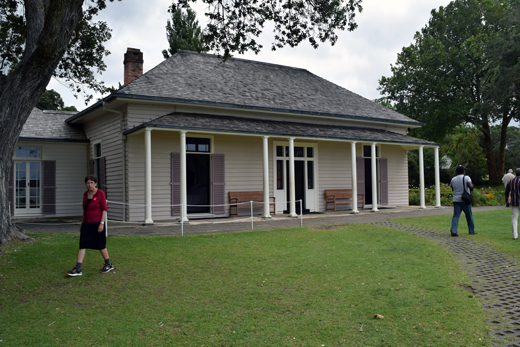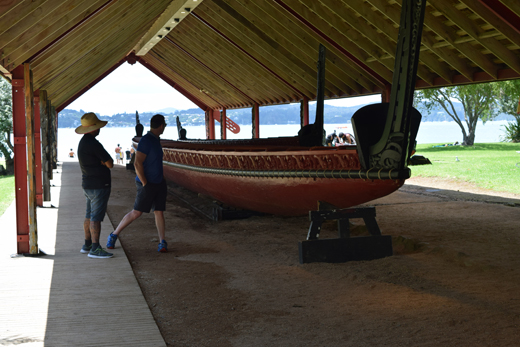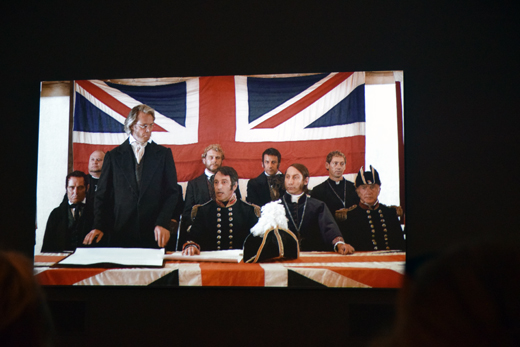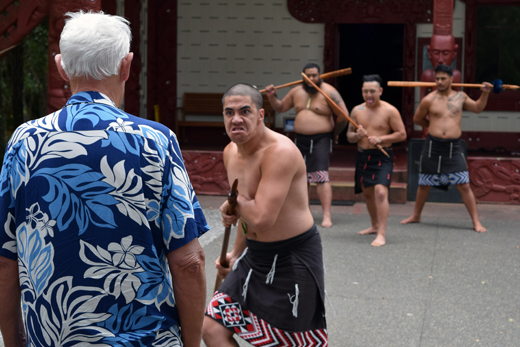
Editor’s Note: This is the 23rd in a series of stories researched during Don and Nancy Harrison’s 50th Wedding Anniversary cruise from Sydney, Australia, to San Diego. Previous installments of the series, which runs every Thursday, may be found by tapping the number of the installment: 1, 2, 3, 4, 5, 6, 7, 8, 9, 10, 11, 12, 13, 14, 15, 16, 17, 18, 19, 20, 21, 22
By Donald H. Harrison

WAITANGI, New Zealand – Sometimes February 6th is called “Waitangi Day,” other times “New Zealand Day,” but whatever it is called, it tends to be controversial as the more militant of the nation’s indigenous Maoris press their case that the government has ignored, abridged, and violated the terms of the 1840 Treaty of Waitangi, which brought their people under British sovereignty.
The year 2009 marked the 169th anniversary of the signing of the Treaty of Waitangi by representatives of the British Crown and some 500 Maori chiefs representing most but not all the villages of New Zealand’s North Island. While preparing for the annual celebration of that treaty, New Zealand’s then-Prime Minister John Key—one of three Jewish descendants who have held the nation’s top political job—was grabbed by the jacket by two protesters who yelled they did not want him to set foot upon Maori ground. Given that Key previously had made alliance between his National party and a Maori political party, also agreeing to allow the Maoris’ own flag to fly from the flagpole at the Waitangi Treaty Grounds, this expression of anger was interpreted as less a protest against Key than it was against the New Zealand government generally. The protesters were taken away, and except perhaps for his dignity Key was not injured.
During the mid-19th century, with France looking to extend its Polynesian empire to New Zealand, and would-be settlers from different countries trying to obtain land from the Maoris, Great Britain offered its protection to New Zealand’s indigenous people along with the full rights of British subjects. In return, Britain was to be declared sovereign over New Zealand, and given the exclusive right to purchase Maori land, if and when Maoris decided to sell it.
Or, at least that is how the British interpreted the English-language version of the treaty. The Maoris’ understanding was very different of the treaty drafted by Henry Williams, a Christian missionary, and his son Edward. Although the Williams family members had learned the Maori language, their knowledge of its subtleties was limited. As the Maoris understood the document written in their language, they had ceded the overall governance of the country to the British, but retained the right to manage their own affairs and to control their “treasures.”
It did not take long for disputes to arise under terms of the Treaty. Like many tribal people, the Maoris originally did not have the concept of individual ownership. Land was owned by all the members of the tribe. Yet, some government agents certified sales from individuals. To deal with this problem, the government unilaterally decided that no more than 10 persons could own a tract of Maori land, a law intended to make land sales easier. But to the Maori, these were arbitrary laws, that worked against their interests.
The extents of land sales were also disputed. Maoris might think that they were selling only a small parcel of their land, but government agents wrote the description to include vast tracts of land.
In the 20th Century, the government established a tribunal to examine land sales, and where appropriate, offer redress. This mandate was taken seriously, with Attorney General Chris Finlayson of the last National government prioritizing settlement of the disputes. Rachel Lerner, an attorney, historian, and member of New Zealand’s Jewish community, commented: “Treaty settlements have resulted in many Maori tribes (known as Iwi) going into business, often most successfully. Ngai Tahu from the South Island have invested in fisheries, housing, etcetera, and used the commercial returns to help the members of the Iwi and to make further investments, often with commercial partners. Similarly Ngati Whatua (Auckland area) have large land holdings and use the rental received for social investment and commercial investment.”
While race relations therefore seem to be improving, there still are some trouble spots, particularly here in Waitangi, home of the Iwi known as the Ngapuhi. Efforts to script Waitangi celebrations this year faltered when Ngapuhi could not agree amongst themselves what should happen.
It should be stressed that discontent is not universal among Maori descendants, the vast majority of whom are of mixed European and Maori ancestry. Many are proud of both sides of their dual heritages. However, as long as some of the issues remain unresolved, they have the capacity of roiling New Zealand politics.
In addition to land disputes, Maori activists have had a litany of other grievances, including what they saw as discrimination in employment, less access to education, lack of social mobility – complaints shared by minority groups in other countries.

Visiting the Waitangi Treaty Grounds, located in New Zealand’s Bay of Islands area, can be a pleasant tourist experience especially for those oblivious to the simmering controversy. A highlight, for example, is seeing the 30-meter long Maori war canoe named “Ngatokimatawhaorua,” which was launched in 1940 for the centennial of the Treaty. Housed under a specially fitted roof to protect it from weathering, the war canoe, known as a “waka” is taken out on special occasions. One hundred paddlers are needed to propel the canoe, which reportedly has gone faster than 20 knots over short stretches.
In 1953, Queen Elizabeth and her husband Prince Philip, the Duke of Edinburgh, visited the grounds, and the royal entourage was back in 1990 for observances of the treaty’s sesquicentennial.
Before Maori activists became militant, protesting injustices and inequalities, New Zealanders of European descent used to pride themselves, somewhat naively, as having no racial problems. It is true that Maori language, art, and customs are honored throughout the country. Given that the official founding of New Zealand officially dates from the day the Treaty was signed, New Zealanders used to brag that unlike many other countries, their nation’s beginning could be traced to an act of peace, rather than one of revolution or war.


There is a museum in the house where the Treaty of Waitangi was signed, with a film reenacting the events of February 6, 1840. Nearby there is a ceremonial Maori meeting place, at which tourists are welcomed after they receive a traditional and colorful Maori challenge, designed to determine whether they come as friends or foes. Once accepted as friends, tourists are invited to take off their shoes before entering—like Moses, we understood we were about to step upon holy ground. Once inside, visitors are treated to traditional Maori hakas and other dances. Videos are not permitted, but still photography is acceptable.
The visit was one of those experiences in which I couldn’t decide whether the proverbial glass was half full or half empty. If 178 years after the signing of Witangi peace treaty, there still is tension between European New Zealanders, called “pakehas,” and the indigenous Maoris, what can we expect will be the result if ever a peace treaty is signed by both Israelis and Palestinians?
*
Harrison is editor of San Diego Jewish World. He may be contacted via donald.harrison@sdjewishworld.com
Pingback: Tonga’s love for the Jews of the Bible | San Diego Jewish World